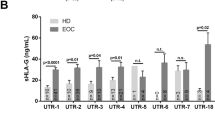Abstract
Molecular-target therapies are novel approaches to the treatment of prostate and ovarian cancer, but to ensure the best response, a very careful selection of patients, based on immunological characteristics, must be performed. We screened for HLA type, 24 patients with advanced ovarian cancer and 26 patients with hormone-refractory prostate cancer, in order to be recruited to vaccine protocols. HLA typing was performed with PCR in ovarian cancer patients and with serological assay in prostate cancer patients. The results were then extended to a population level, comparing the HLA genotype frequencies in Europe with ovarian and prostate cancer mortality rates. An overrepresentation of HLA-A2 phenotype was observed in both patient groups compared to the normal Swedish population (p=0.01). As it is already known, the higher phenotype frequency of this allele found in Scandinavian countries decreases significantly as one moves further south in Europe. Ovarian and prostate cancer mortality rates decrease as well as the demographic changes in HLA-A2. These observations have to be confirmed by more extended investigations in order to elucidate if HLA-A2 higher frequency is already present at the diagnosis (risk factor) or is selected during the course of the disease (prognostic factor). Moreover, this fact would suggest different strategies for specific immunotherapy in addition to first line conventional treatments.
Similar content being viewed by others
References
Hwu P, Freedman RS. The immunotherapy of patients with ovarian cancer. J Immunother 2002;25(3):189–201.
Dalgleish AG, Perry MJ, Eaton JD, Hrouda D, Todryk SM, Kirby RS. The immunotherapy of prostate cancer. Prostate Cancer Prostatic Dis 2000;3(4):303–307.
Mitchell MS, Harel W, Groshen S. Association of HLA phenotype with response to active specific immunotherapy of melanoma. J Clin Oncol 1992;10(7):1158–1164.
Browning M, Dunnion D. HLA and cancer: implications for cancer immunotherapy and vaccination. Eur J Immunogenet 1997;24(4):293–312.
Sosman JA, et al. Adjuvant immunotherapy of resected, intermediate-thickness, node-negative melanoma with an allogeneic tumor vaccine: impact of HLA class I antigen expression on outcome. J Clin Oncol 2002;20(8):2067–2075.
Cavalli-Sforza L, Menozzi P, Piazza A. The history and geography of human genes. Princetown University Press: Princeton, NJ, 1994.
Wang SS, et al. Comprehensive analysis of human leukocyte antigen class I alleles and cervical neoplasia in 3 epidemiologic studies. J Infect Dis 2002;186(5):598–605.
Moore CB, John M, James IR, Christiansen FT, Witt CS, Mallal SA. Evidence of HIV-1 adaptation to HLA-restricted immune responses at a population level. Science 2002;296(5572):1439–1443.
McMichael A, Klenerman P. HIV/AIDS. HLA leaves its footprints on HIV. Science 2002;296(5572):1410–1411.
Author information
Authors and Affiliations
Corresponding author
Rights and permissions
About this article
Cite this article
De Petris, L., Bergfeldt, K., Hising, C. et al. Correlation between HLA-A2 gene frequency, latitude, ovarian and prostate cancer mortality rates. Med Oncol 21, 49–52 (2004). https://doi.org/10.1385/MO:21:1:49
Received:
Accepted:
Issue Date:
DOI: https://doi.org/10.1385/MO:21:1:49




